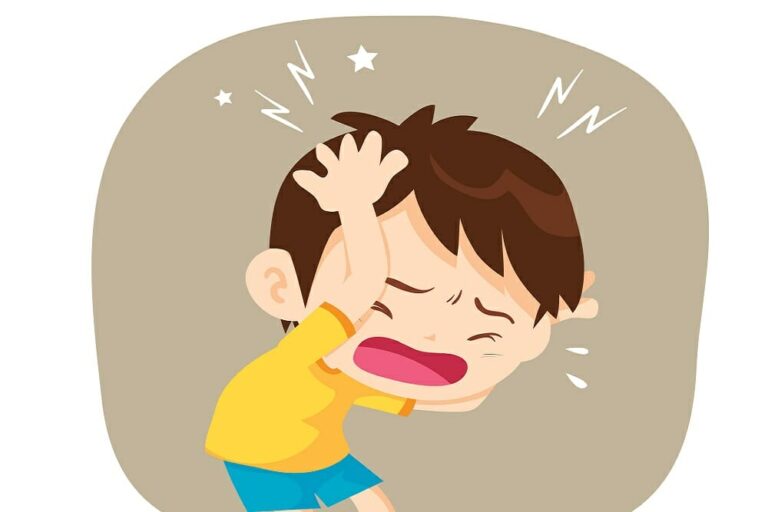
If you’ve ever suffered from a headache, you know how awful it can be. I, knock on wood, don’t get headaches often, but the ones I’ve had have been doozies and I have endless empathy for kids and adults who get them on a regular basis. And of course, when your child has a headache, the first concern that comes to mind is that something is wrong, very wrong.
The first thing you need to know is that the vast majority of headaches do NOT indicate an underlying brain tumor or meningitis. But as a pediatrician, I want to remind you of the warning signs for when to contact your doctor. Take your child to the doctor if he/she:
- Has headaches associated with head injury, even an apparently mild injury.
- Has a headache upon waking, or is worse in the morning after waking.
- Has an associated fever.
- Develops pain or stiffness in the back of the neck when touching the chin to the chest.
- Acts confused, does not make good eye contact, is very sleepy and difficult to wake up, or is unusually fussy, irritable, or truly “inconsolable”
- Is vomiting and can’t keep fluids down.
- Has headaches that last more than a few days.
- Have chronic headaches that worsen or change in pattern or intensity.
- You are very concerned about your child and just want him to be monitored (trust your motherly instincts!).
Now that that’s no longer the case, you know that most childhood headaches can be addressed with holistic approaches and natural remedies.
Tip #1: Stay hydrated
The No. 1 reason for headaches in children is dehydration.
How much fluid should your child drink every day? As a general rule, take your child’s body weight in pounds, divide it in half, and that is the minimum number of grams of fluid your child should drink every day. For example, my six-year-old, 50-pound son should drink at least 25 ounces of fluid every day. And if it’s a very hot day or your child is sweating and losing extra fluid through exercise, she should drink even more!
So WHAT should your child drink? Good old H2O is great. But if your child is dehydrated, a drink with electrolytes is ideal for replenishing those minerals, keeping him hydrated and reducing headaches. Here are some of my favorite liquids for kids:
Coconut water is one of my favorite drinks packed with great electrolytes to keep our cells super hydrated with just the right amount of sugar. I love the taste of coconut water on its own in its unadulterated glory, but you can add a little unsweetened juice if necessary, depending on your child’s taste. You can make natural jello, fruit juice pops, and smoothies with coconut water to keep your kids hydrated. Be as creative as you can!
Herbal tea are another great way to keep your kids hydrated while providing other healing benefits. Chamomile tea soothes, relieves pain and spasms, soothes stomach complaints and fights inflammation caused by fever and colds. Peppermint tea cools the body, relaxes the mind, reduces nausea and helps with pain. Ginger tea reduces nausea and inflammation that often accompany headaches. You can add honey (if your child is over 1 year old), which has its own immune-boosting benefits, or make popsicles, jello, or smoothies with it, just like with coconut water above.
Bone broth! No discussion of hydration would be complete without discussing the amazing healing and hydrating benefits of bone broth. It’s that easy to make? much easier than you think! And most health food stores now sell delicious custom bone broth. Drink it like tea. Use it as a base for your child’s favorite soup. Use it instead of plain water to cook your child’s rice or pasta. The variety of ways you can use bone broth is endless? limited only by your imagination!
Tip #2: Top up with magnesium
There is a huge epidemic of magnesium deficiency. We can pretty much assume that most of us are at least deficient in this wonder mineral. Not only does it relax the body, it also relaxes the mind and is great for headaches! There are different forms of magnesium. They are all relaxing, but magnesium glycinate has the most calming effects. Magnesium citrate can help soften bowel movements if constipation is an associated problem for your child. (Constipation is also common among our children. See my blog post? Oh, crap!? for more tips on how to deal with constipation naturally.)
What dosage? Well, that depends on how inadequate you are to begin with. The RDA for magnesium is approximately 2 milligrams (mg) per pound of body weight. But most people need much more than that. A general rule of thumb would be to take up to 5 times your body weight in milligrams (mg) of magnesium. So my 50 pound six year old could take about 250 mg of magnesium daily. And if he has a really bad headache, he might need even more! The only caveat that you’ll want to work your way up slowly because magnesium can sometimes cause diarrhea?
Epsom salts are another great way to passively get magnesium into your child and relieve headaches. Pour 1/2 1 cup into your child’s bath and sit back and let the calm fill her body. Epsom salts are magnesium sulfate. Our skin is our largest organ, and everything that comes into contact with our skin is absorbed by our body. So just soaking in epsom salt will help increase our body’s magnesium levels. Throw in some healing essential oils, and aahhhh
And please share this post with every parent you know who has a child who suffers from headaches.

